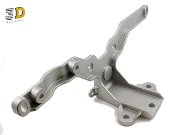Painting and Finishing - Strong & Durable parts.
Posted on Nov 13, 2013
Painting Parts produced using our 'Strong & Durable' service.
Our 'Strong and Durable' service is based around the FDM (Fused Deposition Modeling) 3d printing process.
3D Printed FDM parts can be finished to a high standard for photography or display applications with the correct finishing and painting techniques.
Our 'Strong Durable' FDM based service is our most affordable 3D Printing process and these additional painting and finishing options gives you a lower cost 3D Printing option where you need parts with a specific cosmetic finish.
Before you start:
Finishing FDM 3d printed parts requires a little patience. If we know in advance we can try and build your part in a way to maximise the surface finish and minimise the finishing required. This may alter the cost but reduce the time needed to prepare your part for painting.
It’s worth noting that internal cavities are more difficult to finish, and could be a consideration when you design your part should you need finishing and painting on internal faces.
When exporting your .stl file from your CAD software it's important that the resolution is high enough to ensure smooth curves and faces. Reviewing your .stl file with a .stl viewer before 3D printing will highlight any problem before sending to print. Facets on screen will be reproduced on your finished part and add to the finishing required.
Parts built in ABS are generally easier to finish than those in other FDM materials but ABS is our default material for quoting. Other materials can be finished and painted but being harder need more time to prep.
Your 3D Printed parts will be shipped with support materials removed and ready to prepare for painting.
Finishing & Painting:
Perform an initial smoothing of the outer surface using either fine abrasives, fine beadblasting or a brushed-on solvent.
For beadblasting we'd suggest plastic blast media (PMB), perhaps Polyplus®, which has a Mohs hardness of 3.5 standard sieve size 0.84/0.58 mm. Bead blast pressure should not exceed 100 psi (689 kPa). Start low and gradually increase the pressure until you get the desired result. Setting the pressure too high will damage your parts.
Spray a light coat of primer (optional) to visualize areas that require filler. Allow to dry and then apply body filler to the model in areas where needed and wait for the filler to cure. Sand the filler and clean the part with wax and grease remover. Apply the first coat of primer.
Check the model for any imperfections and fix them with body filler and sandpaper.
Wet sand the model and clean with wax and grease remover. Apply a second coat of primer if necessary and repeat the process until the surface finish of the model meets the requirements of the application.
Apply one or two coats of paint and clear coat, matte or gloss, to protect the paint.
Thanks go out to Stratasys who manufacture our FDM 3D Printing machines and provided the base information in this article.
Latest Posts
3D Printed Materials
OUR CLIENTS SAY

"3D Alchemy provides a service that even professional jewelers will scratch their head in wonderment over. I definitely recommend these guys to anyone looking to explore the brand new territory of direct 3D printing gold and silver jewelry, no matter where they are located in the world."

"Helpful, fast service with good quality of product."


